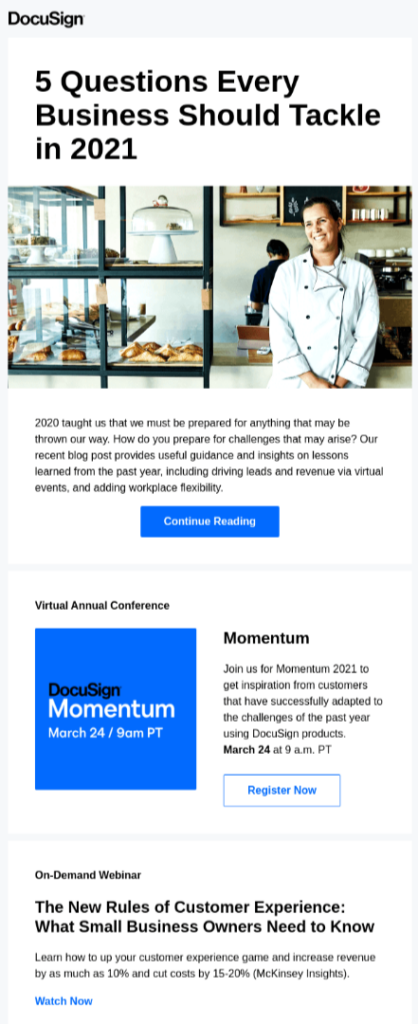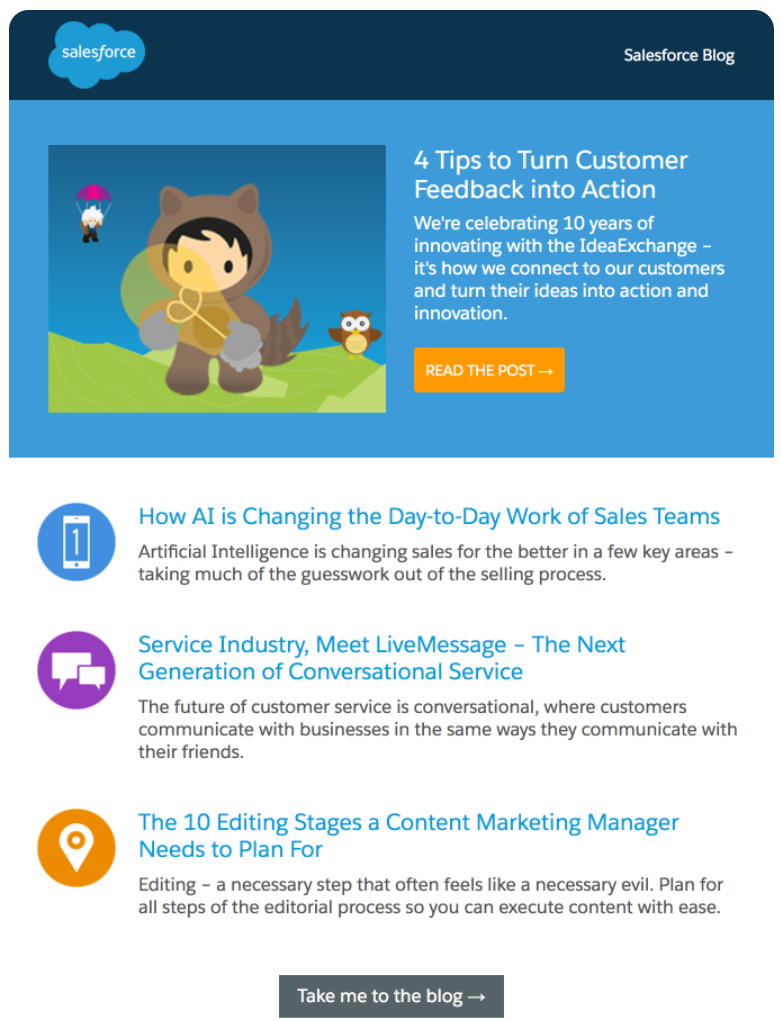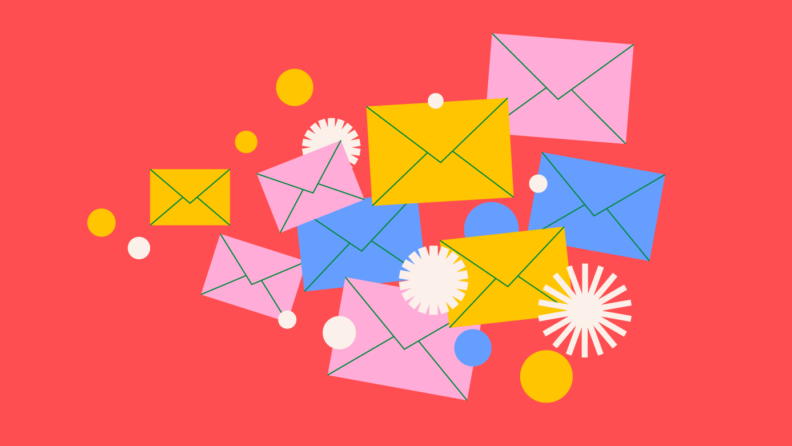Email marketing is a staple of the B2B marketing world, but it’s something many marketers struggle with. It isn't enough to simply build an email list and send out lots of emails, taking a scatter-spray or 'throwing spaghetti at the wall' approach. Successful email marketers know who they’re marketing to, the best time to reach them, and the kinds of problems their messages should help people solve to generate conversions.
In this article, I'll outline some actionable tips that you can use to improve your B2B email marketing efforts, provide some specific examples of companies who are doing a great job with their B2B emails, and share some of my most highly recommended email marketing software. Take a couple (or all) of these tips to test them out in your business, and may you see your results soar!
1. Segment Your Email List
If you run marketing campaigns on social media, you probably already have buyer personas in mind when you’re designing creatives for those campaigns. Treat your email list in a similar way. Use the information you have on your subscribers to segment your lists, so you can personalize your emails to who you're trying to reach, such as key decision-makers at a smaller business who are ready to buy or individuals you met at a trade show.
It’s not uncommon for businesses to have multiple mailing lists targeting different sizes of businesses or different locales. You may opt to maintain lists for current customers, press contacts, lapsed customers, and new leads. When you’re considering how to categorize your customers, ask yourself if what you’re doing will make it more likely that the emails they’ll receive will be relevant to (and therefore opened by) them.
2. Choose A Compelling Subject Line
No guide to B2B email marketing best practices would be complete without mentioning the subject line. Email inboxes are crowded, and the email subject line is the only chance you get to attract a person’s attention. If you have poor open rates, it’s likely your email subjects are lacking in some way. They could be too bland, or they could make your messages look like spam.
If you’re unsure what the issue is, experiment with a few subject lines, and try using A/B testing to see which subjects attract the most attention. Every industry is different, so be ready to experiment until you figure out what works. If it helps, there are some great email marketing templates you can try out.
Whatever subject line you choose, make it descriptive and include your brand name if possible, so people know it’s from you. Not all subscribers will open every single one of your emails, even if they want to remain subscribed. However, your branding benefits from them seeing your name in their email inbox, even if they haven’t read your most recent mail.
3. Include A Strong Call To Action
Once you’ve got people to open your emails, the next challenge is to get them to take action. Try to make each email have a clear point and a call to action (CTA). Depending on your sales pipeline, that call to action could be anything from “visit our website” to “schedule a demo with our sales team."
Whatever it is you want your subscribers to do, make it easy for them to follow through and include clear, visible calls to action in the message.
When it comes to writing calls to action, follow the same rules for emails as you would for more traditional online marketing. Try to choose compelling and descriptive calls to action, such as “Sign up for the webinar” or “Preorder the report.” These descriptive calls typically see a better response than something vague, such as “Click here.”
Make whatever it is you’re asking the reader to do as simple and friction-free as possible. For example, if you’re inviting someone to download a report or join a webinar, don’t make them click a link in an email and then fill out all of their details again. You already know who the user is because you’ve sent them an email. Use this to have some of their details prefilled to save them time.
4. Plan Consistency To Your Campaigns
Spamming your subscribers with too many messages is an effective way of alienating prospective customers. However, if you go too long between sending emails you run the risk of people forgetting that they’ve subscribed.
Even if you don’t run into spam issues, intermittent emails aren’t particularly effective when it comes to generating solid email open and conversion rates. Try to stick to a steady schedule. For example, pick one day of the week and send your messages at a fixed time that day so your audience will get used to seeing your messages. If your email content is good enough they could even come to look forward to them.
Depending on the industry you’re in and the theme of your mailing list, you may be able to get away with sending more frequent emails. For example, a daily news roundup may be popular with some subscribers. Whatever schedule you decide to follow, it’s important to stick to it. Don't switch from a low-volume schedule to a high-volume schedule without your user’s consent. If you're unsure, try hosting a poll in one of your emails asking how frequently they'd like to hear from you.
5. Use Reliable Email Marketing Software
Using a reliable mailing list platform is important for any marketer. However, it’s particularly important for B2B companies that may use email hosting that has aggressive junk mail filtering settings. Some CRM software includes tools to help you manage email subscribers. If yours doesn’t, you may want to use a specialist email marketing platform. Useful features to look out for include:
- Double opt-in lists
- Unsubscribe requests
- Welcome messages
I do have a list sharing some of my preferred email marketing software. These platforms can help you manage your mailing list, keep track of new customers and subscribers, and send out personalized emails. A few favorites include:
- Biteable — Best for video customizations
- Loom — Best for simple video recording
- Viewed — Best for personalized remarketing videos
6. Use Automation To Schedule Emails
Of course, there's also the great invention of email marketing automation software. Tools such as MailChimp allow you to personalize email messages and drip feed marketing messages to new subscribers over time. The platform also helps you create and schedule automated email courses or campaigns.
These tools can save you a lot of time compared to managing messages by hand. They can handle subscription and unsubscribe requests, keep track of open rates and click-through rates, and generate charts and statistics. These metrics can be fed into other software to get a better understanding of how your email marketing is performing compared to your other marketing efforts.
If you’re able to do so, try to schedule the time the messages are delivered, not just the day. If you deal with people in different time zones, schedule messages for their working hours. This will reduce the risk of the message being buried under other messages overnight.
7. Keep Content Scannable
If you’re using email as a major marketing channel, you’ll want to make a good impression on your subscribers. An attractive email template is a good starting point, but the text of the email needs to be clear and easy to read. That means breaking it down into short paragraphs and keeping the formatting simple with plenty of white space.
There are still people out there who use text-only email clients or disable the loading of images in their mail software. Those people could be key decision-makers, so ensuring your emails are accessible is essential.
Keep your emails relatively lightweight. Compress images, always include alt text, and don’t send huge attachments to people unless they’re expecting them. If you fill up someone’s inbox while they’re traveling, you run the risk of them hitting the unsubscribe button once they notice what’s happened.
8. Put Yourself In The Buyer's Shoes
The people you’re targeting with your marketing emails are most likely busy people who have a reasonable amount of power within the business. By subscribing to your mailing list, these people are allowing you to take some of their valuable attention. If you want to remain welcome in their inbox, you need to give them value in exchange for their time.
Think about who your target audience is and the problems they typically face during the working day. What do they need to know about? What could they learn from you? What pain points do they have, that your product can fix?
If you attract new subscribers by offering a free trial of your software or service, sending out tips and tutorials on how to make the most of the trial is a good starting point. You could also offer case studies of other, similar organizations that have made use of the product. Use these case studies to highlight key functionality that you think might interest them.
You can also use your email newsletter to provide tips and advice that are loosely related to your business. For example, if you run a web design agency and you know a lot of your prospects are going to a conference, send a “conference survival guide.” Include networking tips and lighthearted advice about avoiding “the conference flu.”
Free, useful content can attract attention and build goodwill among many of your subscribers. Later in the sales cycle when it’s decision-making time, your audience will be more likely to view your brand in a positive light.
9. Track Metrics And Refine As You Go
As with any other kind of content marketing, metrics are king. Your email marketing analytics tools will most likely have options for you to keep track of things such as new subscribers, deliverability, open rates, and click-throughs.
Check these metrics regularly, and use them to refine your marketing efforts. If people are opening your messages but aren’t clicking through, try changing your email design or tweaking your CTAs. If you don’t have good open rates, consider the subject line or whether the content of your emails is just not appealing.
Remember, the sales process for large business-to-business purchases can take longer than the process of selling cheaper fast-moving consumer goods. The scope of B2B marketing is about building trust and reputation, and it can take a long time to seal a contract.
3 Great B2B Email Marketing Examples
1. Buffer's Welcome Email
When you sign up to Buffer you'll receive a welcome message that is short and simple. It sets the tone for what they offer and delivers a clear message that they're always just an email away.
Buffer's welcome mail is a great example of "less is more." The mail is text only except for the company logo and is entirely clutter-free. Thanks to this, it communicates its message incredibly clearly.

2. Docusign's Mailing List
Docusign's B2B mailing list offers informative articles about online security. The emails they send out include useful information about privacy, data protection, and security. Docusign uses its articles to clear up some concerns prospective customers may have about their software.
What makes the mailing list so effective is that not all of the articles they send out are sales-focused. There are useful, informative articles included that don't directly relate to the products they sell. This is a great example of adding value.

3. Salesforce's Blog Updates
Salesforce offers people the option of subscribing to a mailing list to get blog highlights delivered directly to their inboxes. We're highlighting this update email because of its eye-catching design and the varied types of content included in the emails.
Salesforce is used by people from many industries. They've done a good job of creating a regular email blast that will be appreciated by a wide audience.

Email Marketing Is A Powerful Tool
Email marketing is a powerful tool when it’s used correctly. In fact, it's possible to achieve ROIs in excess of 40:1 with email marketing, depending on the niche.
As with other marketing methods, it can take some time to refine your marketing efforts. With proper list segmentation and well-crafted emails that have a compelling subject, you can feel confident your B2B email messages will get the attention they deserve.
For more marketing tips, news and advice, sign up for The CMO newsletter. We offer actionable tips to help you refine each aspect of your marketing strategy.


